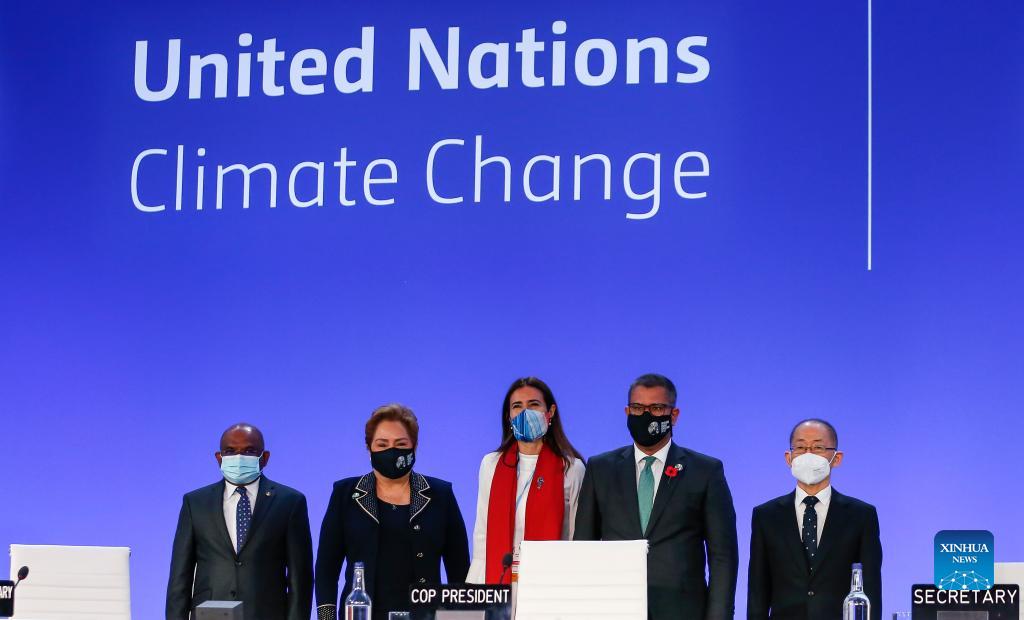'Landmark moment' cited as COP 26 continues
 Photo taken on Oct 31, 2021 shows a general view of the opening ceremony for COP26 in Glasgow, Scotland, the United Kingdom. [Photo/Xinhua]
Photo taken on Oct 31, 2021 shows a general view of the opening ceremony for COP26 in Glasgow, Scotland, the United Kingdom. [Photo/Xinhua]
In the flurry of climate-related materials published last week during the 26th United Nations Climate Change Conference of the Parties, or COP 26, one annual study was among the most worrisome.
The World Meteorological Organization's "State of the Climate 2021" report brought into sharp focus the fact that climate change is no longer tomorrow's challenge-the impacts of global warming are playing out all around us.
Extreme weather events are the new norm, the report said. This year, Canadian glaciers melted rapidly, months' worth of rain fell in just hours in parts of Asia, Europe experienced severe flooding, and Madagascar remains in the grip of climate-induced drought and famine.
It was against this backdrop that COP 26 opened in Glasgow on Oct 31. Negotiations are scheduled to end on Friday, though many previous climate conferences have run over.
The ultimate aim of COP 26 is to ensure that nations meet the targets laid out in the Paris climate agreement, and ensure that global warming is kept under 2 C compared with pre-industrial levels, and preferably close to 1.5 C. New International Energy Agency analysis indicates that if COP 26 commitments are met, global warming could be held to 1.8 C.
"This is a landmark moment: It is the first time that governments have come forward with targets of sufficient ambition to hold global warming to below 2 degrees Celsius," IEA Executive Director Fatih Birol said.
At COP 26, 114 countries, including China, have agreed to halt and reverse deforestation over the next decade. In addition, more than 100 nations signed on to a global partnership to reduce methane emissions by 30 percent by 2030.
In addition, COP 26 President Alok Sharma said that developed nations are on course to raise $500 billion in climate financing for developing regions over the next five years, and 23 nations committed to targets for the first time to eventually phase out coal power generation.
The conference also witnessed pledges on net-zero carbon emissions and updated emissions reduction targets-known as nationally determined contributions-from large emitters including India and major emerging markets such as Nigeria.
China followed up its earlier pledge to peak carbon emissions before 2030 and reach carbon neutrality before 2060 with an updated nationally determined contribution and detailed action plans to deliver on its emissions targets.
The Energy Transitions Commission estimates that, in order to meet the Paris goals, carbon dioxide emissions need to be cut from the 43 gigatons that they could reach on a "business as usual" path to around 21 gigatons by 2030.
If implemented, some of the COP 26 pledges could make substantial inroads into closing this gap, said Adair Turner, chairman of the commission.
"The commitment to end deforestation, if supported by appropriate finance and delivered, would itself result in 3.5 gigatons of emissions reductions," Turner said. "Add it all up with the (nationally determined contributions) and the sectoral commitments, and we are probably on a path to about 9 gigatons of reductions out of the 22 needed."
Negotiators will next tackle the transportation sector and the built environment, including high emissions industries such as steel, aviation and shipping.
Turner said that, regardless of the outcome of commitments in these areas, the 22 gigaton goal will not be met. "We're not going to be able to go home from Glasgow saying 'job done'."
The IEA's Birol warned that there is a difference between words and action.
"Ambitions count for little if they are not implemented successfully," Birol said.
Zhang Jun, China's senior envoy to the United Nations, wrote on Twitter, "Responding to climate change requires unbending determination and sustained action, not empty slogans."